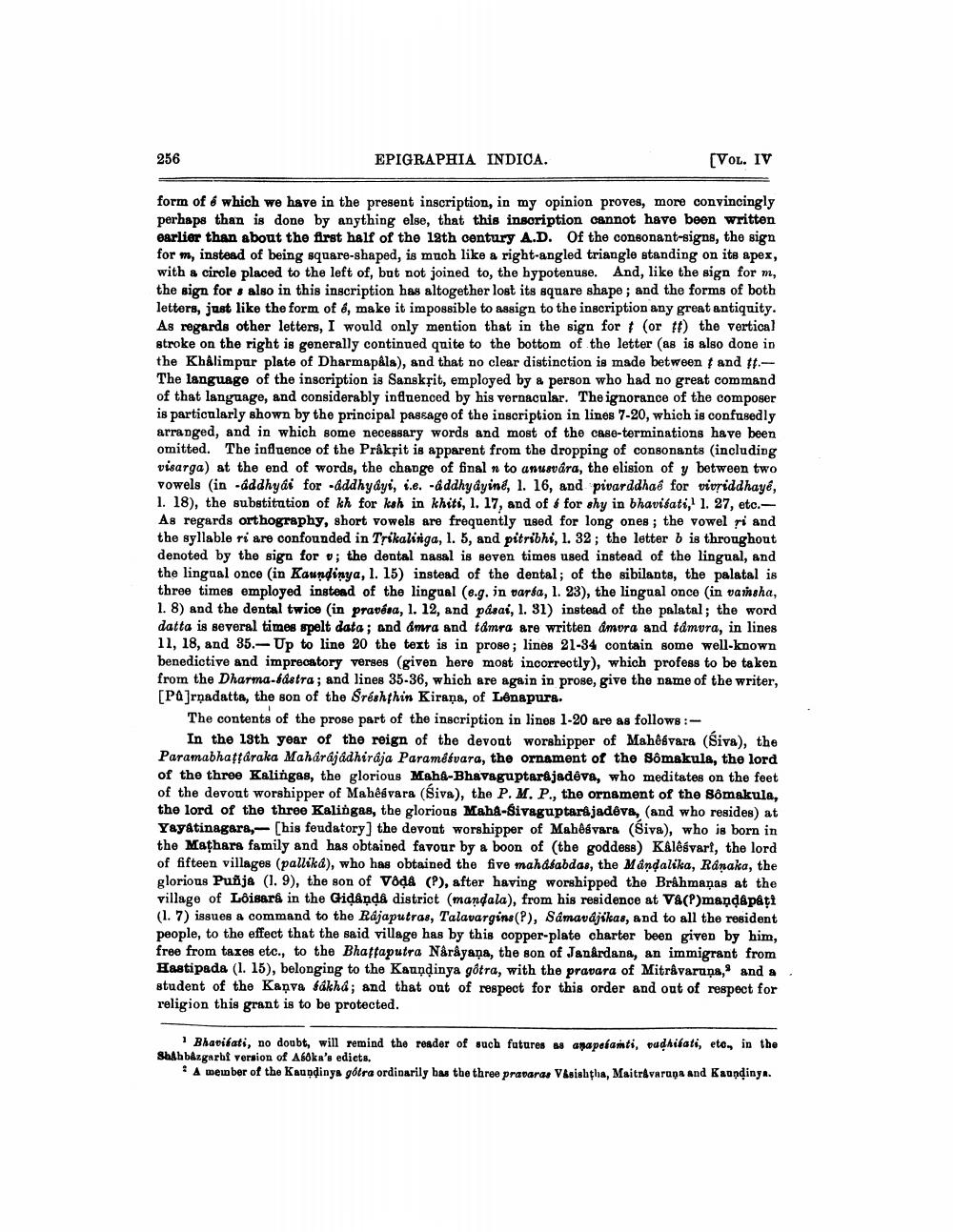________________
256
EPIGRAPHIA INDICA.
(VOL. IV
form of 6 which we have in the present inscription, in my opinion proves, more convincingly perhaps than is done by anything else, that this inscription cannot have been written earlier than about the first half of the 19th century A.D. Of the consonant-signs, the sign for m, instead of being square-shaped, is much like a right-angled triangle standing on its apex, with a circle placed to the left of, but not joined to, the hypotenuse. And, like the sign for m, the sign for s also in this inscription has altogether lost its square shape; and the forms of both letters, just like the form of é, make it impossible to assign to the inscription any great antiquity. As regards other letters, I would only mention that in the sign for t (or ft) the vertical stroke on the right is generally continued quite to the bottom of the letter (as is also done in the Khâlimpar plate of Dharmapala), and that no clear distinction is made between t and 1.The language of the inscription is Sansksit, employed by a person who had no great command of that language, and considerably influenced by his vernacular. The ignorance of the composer is particularly shown by the principal passage of the inscription in lines 7-20, which is confusedly arranged, and in which some necessary words and most of the case-terminations have been omitted. The influence of the Präkfit is apparent from the dropping of consonants (including visarga) at the end of words, the change of final n to anusvára, the elision of y between two vowels (in -addhyai for - addhyayi, i.e. -addhyayiné, l. 16, and pivarddhad for vivriddhaye, 1. 18), the substitution of kh for ksh in khiti, 1. 17, and of 6 for shy in bhavitati, 1. 27, etc.As regards orthography, short vowels are frequently used for long ones; the vowel ri and the syllable ri are confounded in Trikalinga, 1. 5, and pitríbhi, 1. 32; the letter b is throughout denoted by the sign for v; the dental nasal is seven times used instead of the lingual, and the lingual once (in Kaundinya, l. 15) instead of the dental; of the sibilants, the palatal is three times employed instead of the lingual (e.g. in varsa, 1. 23), the lingual once in vamsha, 1. 8) and the dental twice (in pravána, 1. 12, and pásai, 1. 91) instead of the palatal; the word datta is several times spelt data ; and amra and támra are written amura and tamura, in lines 11, 18, and 35.- Up to line 20 the text is in prose; lines 21-34 contain some well-known benedictive and imprecatory verses (given here most incorrectly), which profess to be taken from the Dharma-fdstra; and lines 35-36, which are again in prose, give the name of the writer, [Pajrnadatta, the son of the Sreshthin Kirana, of Lenapura.
The contents of the prose part of the inscription in lines 1-20 are as follows:
In the 13th year of the reign of the devout worshipper of Mahêsvara (Siva), the Paramabhatfaraka Maharajadhiraja Paramétvara, the ornament of the Sômakula, the lord of the three Kalingas, the glorious Maha-Bhavaguptarjadeva, who meditates on the feet of the devout worshipper of Mahêsvara (Śiva), the P. M. P., the ornament of the Sômakula, the lord of the three Kalingas, the glorious Maha-Sivaguptarë jadeva, (and who resides) at Yayatinagara, - [his feudatory] the devont worshipper of Mahégvara (Siva), who is born in the Mathara family and has obtained favour by a boon of the goddess) Kalēsvart, the lord of fifteen villages (pallika), who has obtained the five mahasabdas, the Mandalika, Ranaka, the glorious Puñja (1.9), the son of Voda (P), after having worshipped the Brahmaņas at the village of Loisard in the Gidåndå district (mandala), from his residence at Va(P)manda pați (1. 7) issues a command to the Rajaputras, Talavargins(P), Sámavájékas, and to all the resident people, to the effect that the said village has by this copper-plate charter been given by him, free from taxes etc., to the Bhattaputra Narayana, the son of Janârdana, an immigrant from Hastipada (1. 15), belonging to the Kaundinya gôtra, with the pravara of Mitråvaruņa,' and a. student of the Kaņva fákhd; and that out of respect for this order and out of respect for religion this grant is to be protected.
1 Bhavitati, no doubt, will remind the reader of such futures as anapalahti, pudhiali, eto, in the Shahbâzgarbi version of Asoka's edicts.
? A member of the Kaundinya gótra ordinarily has the three pravara, Vboishtha, Maiträvarana and Kaundinya.




